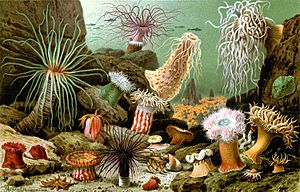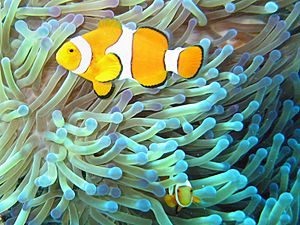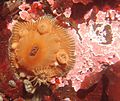Sea anemone facts for kids
Quick facts for kids Sea anemones |
|
|---|---|
 |
|
| A selection of sea anemones, painted by Giacomo Merculiano, 1893 |
|
| Scientific classification |
|
| Kingdom: | Animalia |
| Phylum: | Cnidaria |
| Class: | Anthozoa |
| Subclass: | Hexacorallia |
| Order: | Actiniaria |
| Suborders | |
|
|
| Diversity | |
| 46 families | |


Sea anemones are amazing animals that live in the ocean. They are related to corals and jellyfish. Anemones look a bit like colorful flowers, but they are actually predators! They wait for small fish or crabs to come close.
These animals are called polyps. This is a basic body shape for their group, the Cnidaria. Sea anemones usually stay in one spot. They can move very slowly along the ocean floor. Some types can even swim a little by wiggling their bodies.
Contents
What are Sea Anemones?
Sea anemones are hunters of the sea. They catch their food using special stinging cells called nematocysts. These cells are like tiny harpoons. They shoot out and deliver a small amount of neurotoxin (a type of poison). This poison makes their prey (the animal they are hunting) unable to move.
Once the prey is paralyzed, the anemone uses its tentacles to pull the food into its mouth. The food then goes into its stomach, where it is slowly digested.
Where Do They Live?
Sea anemones can be found in many different parts of the ocean. Many species live in rockpools along the coast. You can often see them on rocky shores when the tide is low.
They also live in the deep parts of the ocean. A few types even float freely in the open water, far from the bottom.
Body Parts
A sea anemone has a few main body parts. At the very top is the oral disk. This disk has the anemone's mouth and gut in its center.
Around the oral disk are the tentacles. These are the parts that sting and catch food. At the very bottom of the sea anemone is the pedal disc. This is how the anemone attaches itself to rocks or the seafloor.
Friends in the Sea (Symbiosis)
Some sea anemones have special friendships with other animals. This is called symbiosis, which means two different living things help each other.
- Clownfish are famous for living safely among the anemone's stinging tentacles. The clownfish gets a safe home, and it might help the anemone by cleaning it or attracting other fish.
- Other animals like Incognito gobys and arrow crabs also find shelter in the anemone's tentacles.
- Sometimes, Hermit crabs will carry sea anemones on their shells. The anemone protects the crab, and the crab helps the anemone move around to find food.
Anemones can also have a symbiotic relationship with tiny plant-like organisms called algae. These algae live inside the anemone's body. They use sunlight to make food, just like plants do. The anemone then uses some of this food to grow and stay healthy. This is similar to how many corals get some of their food.
Early Studies of Anemones
One of the first people to study sea anemones in detail was a naturalist named Philip Henry Gosse. He looked closely at the anemones found near the beaches of the British Isles.
Images for kids
-
A collection of sea anemones drawn by Ernst Haeckel for his book Kunstformen der Natur.
-
The Venus flytrap sea anemone is a suspension feeder, meaning it catches tiny bits of food from the water current.
-
An Ocellaris clownfish hiding among the tentacles of a sebae anemone.
-
(2) and (3) Mackenzia, from the Middle Cambrian period. Sea anemones don't usually leave good fossils because they have no hard parts. This one was first thought to be a sea cucumber.
See also
 In Spanish: Anémona de mar para niños
In Spanish: Anémona de mar para niños









